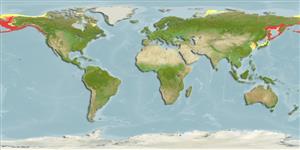Environment: milieu / climate zone / depth range / distribution range
Ecology
Marine; demersal; depth range 0 - 380 m (Ref. 50550). Temperate
North Pacific: Sea of Japan to Point Hope, Alaska in the Chukchi Sea to Amchitka Island in the Aleutian chain and southeastern Alaska.
Size / Weight / Age
Maturity: Lm ? range ? - ? cm
Max length : 32.0 cm TL male/unsexed; (Ref. 56527); max. published weight: 760.00 g (Ref. 56527)
Dorsal spines (total): 7 - 8; Dorsal soft rays (total): 12 - 15; Anal spines: 0; Anal soft rays: 10 - 13. Dorsal surface of head rough with 2 pairs of developed bony ridges; uppermost preopercular spine long and straight with some ascending processes dorsally in adults (Ref. 559). Lateral line scales large and with a rough posterior margin (Ref. 559).
Life cycle and mating behavior
Maturity | Reproduction | Spawning | Eggs | Fecundity | Larvae
Eschmeyer, W.N., E.S. Herald and H. Hammann, 1983. A field guide to Pacific coast fishes of North America. Boston (MA, USA): Houghton Mifflin Company. xii+336 p. (Ref. 2850)
IUCN Red List Status (Ref. 130435: Version 2024-1)
Threat to humans
Harmless
Human uses
Tools
Special reports
Download XML
Internet sources
Estimates based on models
Preferred temperature (Ref.
123201): 0.1 - 6.6, mean 2.3 °C (based on 657 cells).
Phylogenetic diversity index (Ref.
82804): PD
50 = 0.5625 [Uniqueness, from 0.5 = low to 2.0 = high].
Bayesian length-weight: a=0.00589 (0.00281 - 0.01234), b=3.15 (2.97 - 3.33), in cm total length, based on LWR estimates for this (Sub)family-body shape (Ref.
93245).
Trophic level (Ref.
69278): 3.8 ±0.2 se; based on diet studies.
Resilience (Ref.
120179): Low, minimum population doubling time 4.5 - 14 years (Preliminary K or Fecundity.).
Fishing Vulnerability (Ref.
59153): Low vulnerability (22 of 100).
Nutrients (Ref.
124155): Calcium = 53.8 [22.1, 115.6] mg/100g; Iron = 0.332 [0.152, 0.712] mg/100g; Protein = 17.4 [15.2, 19.6] %; Omega3 = 0.648 [0.285, 1.816] g/100g; Selenium = 17.9 [8.2, 40.8] μg/100g; VitaminA = 21.7 [6.1, 70.4] μg/100g; Zinc = 0.633 [0.416, 1.051] mg/100g (wet weight);
